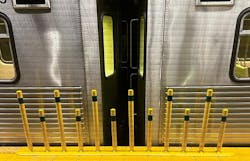Maryland Transit Administration installs safety barriers on subway platforms
To increase station safety, the Maryland Department of Transportation (MDOT) Maryland Transit Administration (MTA) has begun installing safety bollards – short, sturdy vertical posts that serve as physical barriers – at all of the agency’s 14 Metro Subway stations from Owings Mills to Johns Hopkins.
The bright yellow bollards create a barrier to prevent passengers from stepping off the platform between railcars. The bollards are positioned in front of the gaps between railcars (as shown in the photo above) and prevent riders, especially those with visual impairment, from mistaking the gap for a train door opening.
“Ensuring the safety and security of our passengers remains at the forefront of our mission,” said Maryland Transit Administrator Holly Arnold. “The installation of these bollards aligns with our ongoing commitment to provide safe and accessible transit service for all.”
Work to install the new posts began Dec. 3, 2023, at the Owings Mills station and construction is not expected to impact service. Each station will be outfitted with 10 posts, providing protection whether two-, four- or six-car Metro Subway vehicles are operating. The new train control system allows trains to stop at a precise location in each station so that the gap between cars will align with the new barriers. Transit agencies in cities across the United States, including Los Angeles, St. Louis and Pittsburgh, have installed similar devices.
This initiative was launched after the unveiling of a new federal safety requirement designed to ensure riders do not inadvertently step off a platform between cars. A team comprised of multiple transit agency departments and personnel worked in partnership with the National Federation for the Blind, Blind Industries and Services of Maryland and the agency’s Citizens Advisory Committee and Citizens Advisory Committee for Accessible Transportation.
The agency organized a workshop to demonstrate barriers designed to meet the regulatory requirements and to gather feedback from representatives of the blind and visually impaired community. The demonstration took place September 2021 at Johns Hopkins Station, and input from participants was used to further refine elements of the barriers and their operation.
